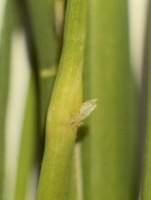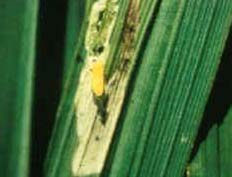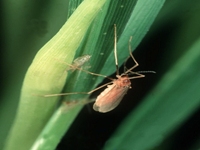|
Gall midge
| Symptom of Damage : |
- Presence of silver shoot or “onion leaf” in the place of central leaf is the prominent symptom.
- The symptom appears from the nursery to the flowering stage.
- Formation of a hollow cavity or tubular gall at the base of the infested tiller.
- Infected tillers inhibit growth of leaves and fails to produce panicles.
- Stunted plants and deformed, wilted, and rolled leaf
|
 |
 |
| Presence of onion or silver shoot |
Presence of tubular galls |
|
| Top |
| Identification of pest : |
|
Scientific Name - Orseolia oryzae
- Egg :
Reddish, elongate, tubular eggs just near the ligule of the leaf blade
- Larva :
Maggot is pale to red colour feeds inside the gall.
- Pupa :
Pupates at the base of the gall and moves to tip of the gall.
- Adult :
Adult is orange coloured mosquito like fly |
 |
 |
| Egg |
Maggot |
 |
 |
| Adult |
Adult |
|
| Top |
| Management Strategies: |
|
Cultural Methods:
- Use resistant varieties like MDU 3, Shakthi, Vikram, Sureka, Pavithra, Panchami and Uma.
- Avoid late transplantation during the first crop season.
- Harvest the crop and plough immediately.
- Use optimum seed rate of 100 kg/ha.
- Optimum recommendation of potash fertilizer.
- Destruction of collateral host like wild rice Cynodon dactylon, Ischaemum aristatum, Echinochloa spp. and Isachne sp.
- Setup light trap and monitor the adult flies.
|
 |
 |
| Infra red light traps |
Use resistant variety -
MDU 3 |
| |
|
Chemical Methods:
- Dipping germinated seed in 0.2% chlorpyrifos solution for 3 hours before sowing give protection up to 30 days.
- In transplanted crop the root of seedlings may be dipped in 0.02% chlorpyrifos suspension for 12 hours prior to planting.
- In areas where the pest is of regular occurrence, apply granules of phorate 10G (1.5 kg ai/ha), carbofuran 3G (0.5 kg ai/ha), quinalphos (1.5 kg ai/ha) or chlorpyrifos 10G (0.5 kg ai/ha) within 10 days after sowing. The granules should be broadcast in 2-3 cm of water and the field should be impounded for at least 4 days.
|
 |
 |
| Apply phorate granules |
Root dipping of seedlings in chlorpyriphos |
| |
|
Biological Methods:
- Natural biological control agents such as platygasterid, eupelmid, and pteromalid wasps, which parasitize the larvae, is effective.
- Release of platygaster oryzae parasitized galls @ 1 per 10 sq.m in the main field on 10 DAT against gall midge.
- The pupa is host to two species of eupelmid wasps.
- Phytoseiid mites feed upon the eggs, whereas spiders eat the adults.
|
 |
 |
| Larval parasitoid - Platygaster oryzae |
Spider predator - Tetragnatha |
| |
| Top |
|












